
©Woolly Thoughts 2020
NAPIER’S BONES
Click pictures for enlargements
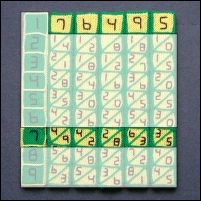
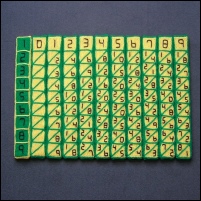
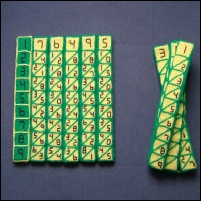
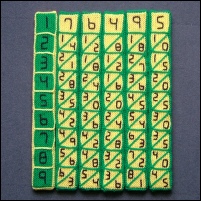
Knit a set of Napier’s Bones (also known as Napier’s Rods) as a fun way to learn multiplication. Children love them. The knitted bones are far more tactile than the wooden versions you might find elsewhere. They have a thin foam filling to make them flexible and almost indestructible. You can stiffen them with card or plastic strip, if you prefer.
There are ten ‘working’ bones and a contrasting ‘multiplier’ bone.
Note: The numbers have to be applied after the knitting is finished. They cannot be knitted in as you go, unless you make the bones bigger, because there is not enough space inside the boxes.
Napier’s Bones were the forerunner of the slide rule, adding machine and calculator. They were invented by John Napier who was born in Scotland in 1550 and were based on the Gelosia method of multiplication, which had been introduced to Europe, from India, around 1200, by Fibonacci (The man with the rabbits and the famous number sequence). They were mainly used for multiplication and division although two other, more complicated, bones were added later to do other calculations.
The photograph shows how to do the calculation 76495 x 7 The numbers you don’t need have been blanked out.
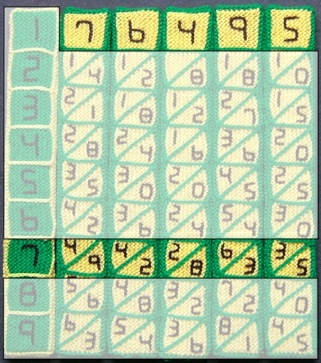
Start at the right-
The next parallelogram has a 3 and a 3. Add these together to get 6 as the next digit (working from right to left)
The next parallelogram has a 6 and an 8. Add these together to get 14. Write down the 4 as the next digit and carry the 1.
The next parallelogram has a 2 and a 2. Add these together with the 1 carried from before, to get 5.
The next parallelogram has a 4 and a 9. Add these together to get 13. Write down the 3 as the next digit and carry the 1.
The final number is 4. Add it to the 1 that was carried, to give 5.
The answer is 535465
The bones can be used to multiply much bigger numbers with several digits in each.
The pattern includes more examples of multiplication and division.


| Introduction |
| Photos |
| Penrose Table |
| Needle Gauges |
| Tribute |
| Little Yellow Duck Project |
| Outside our house |
| Inside our house |
| New Photos 2011 |
| Dialysis photos |
| Other tributes |
| Maths & Puzzles |
| Puppets |
| Sum Wear |
| Toilet Roll Covers |
| Jewellery Dolls |
| Cushy Numbers |
| Pillows of Wisdom |
| Flexagon Cushions |
| Other Cushions |
| Spirals |
| Sweaters - Introduction |
| Hats |
| Scarves & Shawls |
| Crochet Möbius |
| Mathemagical Mittens |
| Mathematical Slippers |
| Simply Circles |
| Roman Mosaics |
| Woolly Thoughts Sweaters |
| Second Thoughts Sweaters |
| More Second Thoughts Sweaters |
| Waistcoats |
| Baby Jackets |
| Irrationals |
| Optical Illusions |
| Hyperbolic Hats |
| Octohats |
| Klein Bottle Hats |
| Mufflermatics |
| The Imitation Game |
| To Bias Or Not To Bias |
| Mostly Holes |
| Enwrapture |
| Maelstrom |
| Windmills Poncho |
| Cats |
| Dogs |
| Sheep |
| Eggsentricities |
| On a Roll |
| Snakes |
| The Sequel |
| Cushion Conglomeration Caper |
| Where to find us |
| Workshops |
| Afghans for schools |
| Group projects |
| Illusion Knitting Tutorials |
| Photos & Comments |
| Want a workshop? |
| South Tynedale |
| Tregarth |
| St Alban's |
| West Jesmond |
| St Oswald's |
| Beckermet |
| Earth School |
| Other schools |
| Cheshire WI |
| East Yorkshire WI |
| Beds Alzheimers Soc |